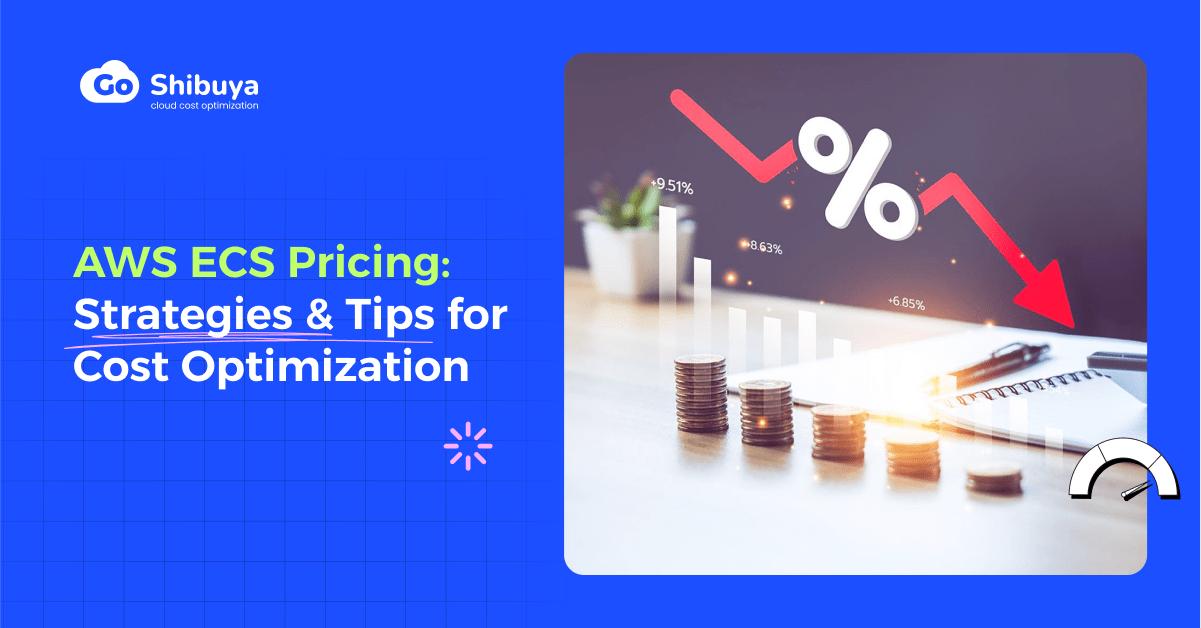Amazon Web Services (AWS) offers plenty of cloud services that cater to diverse computational needs. Among these, the Amazon Elastic Container Service (ECS) stands out for its scalability, speed, and efficient container management. However, navigating the various pricing models and options can seem daunting.
In this article, we’ll take a closer look at AWS ECS, its pricing structure, and strategies to optimize costs, helping you effectively leverage the power of AWS cloud without straining your budget.
Uncover opportunities to optimize your cloud, simplify cloud management, and reduce costs.
How is AWS ECS Priced?
Despite common misconceptions, ECS does not require any minimum fees or upfront costs to use it. Instead, you pay for the AWS resources that you create or use to run your applications. This includes resources like EC2 instances or EBS volumes. The costs depend on several factors, including instance type, region, and data transfer amounts. Additionally, if you use associated services such as AWS Fargate, Amazon ECR, or CloudWatch, each carries its own cost.
Manage your single or multi-cloud infrastructure and cut down on your cloud bill.

Models of Amazon ECS Pricing
When running tasks or services with ECS, you can choose from three main pricing models: AWS Fargate, Amazon EC2, and AWS Outposts.
AWS Fargate launch type
Fargate is a serverless compute engine for containers that works with both ECS and EKS (Elastic Kubernetes Service). Instead of selecting an Amazon EC2 instance type, with Fargate, you specify the CPU and memory requirements for your tasks, and Fargate provisions the optimal quantity of resources. This relieves the user from the responsibility of server management, and you only pay for the resources that your applications actually consume.
Here’s a breakdown of how AWS ECS Fargate is priced:
- vCPU: The price depends on the number of virtual CPUs (vCPUs) used by the task. It’s charged per vCPU hour.
- Memory: The cost is based on the memory used by the task, charged per GB-hour.
The billing is calculated according to the following parameters:
- Number of ECS tasks you ran during the period
- Duration each task ran
- Number of virtual CPUs (vCPUs) used for the task
- Memory used for the task in GB
| Resource | Unit | Pricing |
| vCPU | per vCPU-hour | $X.XX |
| Memory | per GB-hour | $X.XX |
The actual cost will depend on the region and the specific configurations of your tasks. For the most accurate and up-to-date pricing, you should refer to the official AWS Fargate pricing page.
Example of AWS Fargate Cost Calculating
Suppose you ran the following ECS workload in a certain week:
- 20 tasks
- Each running for 30 minutes per day = 210 minutes total = 3.5 hours
- Each task using 1 vCPU
- Each task using 2 GB RAM
The cost of ECS on Fargate for the week would be calculated as follows:
Number of Tasks * Number of hours * (Cost of vCPUs + Cost of RAM)
This pricing model provides flexibility and allows you to pay only for the resources you use, making it a cost-effective choice for running containerized applications on AWS.
Amazon EC2
The pricing of AWS ECS EC2 Launch Type is primarily based on the cost of the underlying EC2 instances and EBS volumes used. There is no additional charge for the ECS service itself.
How AWS ECS EC2 Launch Type is priced:
- EC2 Instances: You pay for AWS resources (such as EC2 instances) that you create to store and run your application. You only pay for what you use as you use it; there are no minimum fees and no upfront commitments.
- EBS Volumes: Amazon EBS volume pricing is based on the size and type of the volume used. You pay for the amount you provision in GB per month until you release the storage.
There are five ways to pay for Amazon EC2 instances:
- On-Demand Instances: Pay for compute capacity by the hour or second, depending on the instances you run.
- Reserved Instances: Provide you with a significant discount (up to 75%) compared to On-Demand instance pricing.
- Spot Instances: Allows you to request spare Amazon EC2 computing capacity for up to 90% off the On-Demand price.
- Savings Plans: Offers significant savings on Amazon EC2 instances usage, regardless of instance family, size, OS, tenancy, or AWS Region.
- Dedicated Hosts: Physical EC2 servers dedicated for your use which can help you reduce costs by allowing you to use your existing server-bound software licenses.
The actual cost will depend on the region, the specific configurations of your instances, and the pricing model you choose.
This pricing model provides flexibility and allows you to optimize costs based on your specific needs, making it a cost-effective choice for running containerized applications on AWS.
Related content: check our AWS EC2 pricing guide to get more insights.
AWS Outposts
AWS Outposts is a robust, fully-managed service provided by Amazon Web Services that extends its cloud infrastructure, services, APIs, and tools directly to your on-premises data center. This unique offering allows you to construct and operate applications on a hybrid infrastructure, combining the power of the cloud with the necessity of on-premises data storage and processing.
When it comes to pricing, AWS ECS on Outposts adopts a straightforward model, mirroring its cloud-based counterpart. The ECS control plane, responsible for managing your containerized applications, remains in the AWS cloud while your containers operate on the EC2 capacity provided by Outposts. Importantly, there is no additional cost for running your container instances on this EC2 capacity – you only pay for the resources your containers consume.
AWS Outposts offers a range of configuration options, allowing you to pool together resources such as EC2 instances, EBS volumes, and S3 storage. However, it’s important to note that costs may be incurred for installation, delivery, upgrades, software patches, and the maintenance of infrastructure services. For a detailed breakdown of these costs, the AWS Outposts pricing page is a valuable resource.
Choosing to host your ECS containers on AWS Outposts can be a strategic decision, particularly for use cases that necessitate on-premises data storage or applications with stringent low latency requirements. While the cost of AWS Outposts can be higher compared to other cloud-based compute options, the value it provides for specific workloads can be substantial, offering a unique blend of on-premises control with cloud-based flexibility.
Ways to Reduce and Optimize ECS Costs
There are several ways to effectively manage and reduce your AWS ECS costs. Let’s look at some of them:
Spot Instances
Spot Instances offer spare Amazon EC2 computing capacity at steep discounts compared to On-Demand prices. By launching your ECS tasks on Spot Instances, you can optimize costs significantly. However, Spot Instances come with the risk of being interrupted, so they are best suited for fault-tolerant and flexible applications.
Auto Scaling
Auto Scaling allows you to scale your resource capacity up or down automatically according to conditions you define. This way, you can ensure that you are not over-provisioning resources, which in turn optimizes costs.
AWS Savings Plans
AWS Savings Plans offer significant savings on AWS usage, similar to Reserved Instances, but with more flexibility. These can be applied to ECS tasks running on EC2 instances or Fargate. With a one- or three-year commitment, you can receive a substantial discount compared to On-Demand rates.
Multiple Load Balancer
You can decrease costs by carefully choosing the appropriate type of load balancer (Application Load Balancer, Network Load Balancer, or Classic Load Balancer) and sharing it across multiple services in the same cluster rather than having one per service.
Right-Sizing Containers
By accurately defining the CPU and memory for each task or service, you can ensure that you’re not over-allocating resources, which can result in unnecessary costs. The CloudWatch service can help monitor and track resource usage to help you make more precise decisions.
Resource Tagging
Tagging resources can provide better visibility into cost and usage. These tags can then be used to filter views in the cloud cost management tool, allowing you to identify and analyze cost trends for specific resources.
Case Studies for Using AWS ECS Pricing Models
Online Retailer
Suppose an online retailer uses AWS ECS with Fargate to manage their microservices-based architecture. They use multiple small services, each performing distinct functions — inventory management, user authentication, payment processing, etc.
To cut costs, the company could use Spot Instances for non-critical services, like reporting and analytics, which can tolerate potential interruptions. Critical services like user authentication and payment processing could run on On-Demand Instances to ensure maximum availability.
They might also use Auto Scaling to handle peaks in traffic during sale events or holidays. By right-sizing their containers and carefully managing resources, they ensure that they are not over-allocating and thus overpaying.
Software Development Company
In another example, a software development company uses AWS ECS with EC2 launch type for continuous integration and continuous deployment (CI/CD). They use multiple EC2 instances to handle different development environments and services.
By implementing AWS Savings Plans, they commit to a certain level of usage and earn significant discounts. They could also use resource tagging to track costs for individual projects or teams, ensuring each unit bears its financial load.
Maximize AWS ECS Efficiency and Savings with Shibuya
While AWS ECS can seem complex and potentially expensive at first glance, understanding its pricing models and leveraging cost optimization strategies can ensure that you harness the full power of this service efficiently and economically. Remember, successful cost optimization is not a one-time event but a continuous process of analysis and adjustment as your needs evolve.
With a professional AWS cloud cost optimization platform like Shibuya, you can significantly simplify and optimize the entire process of managing your AWS infrastructure while cutting down on your AWS ECS costs. Book a demo with our sales team today to get a deeper insight into how Shibuya can help you ensure maximum savings and reduce your overall cloud bill.
